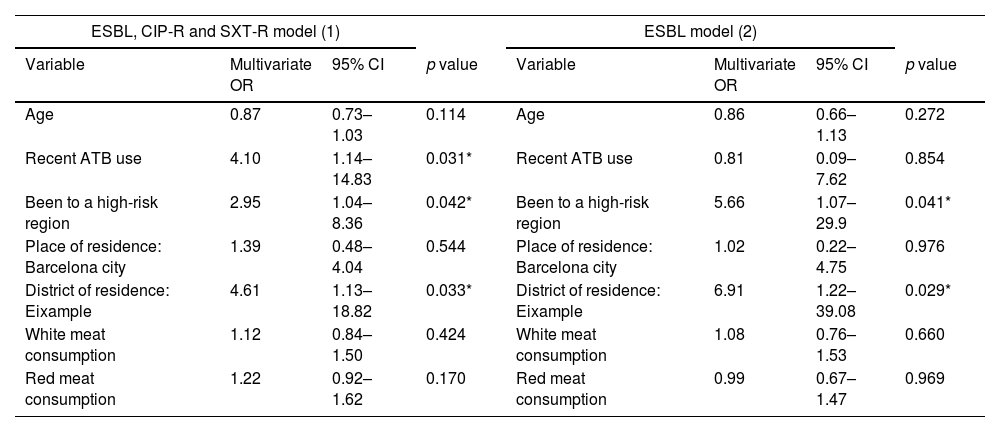To determine the prevalence of and risk factors for extended-spectrum beta-lactamase-producing Enterobacterales (ESBL-PE) faecal carriage among healthy volunteers from Barcelona, and to estimate the pooled prevalence in the community in Spain.
MethodsUniversity students were asked to complete a questionnaire and provide a rectal swab, which was tested for ESBL-producing, ciprofloxacin- and trimethoprim–sulfamethoxazole-resistant Enterobacterales. Risk factors for carriage of antimicrobial resistance were identified by multivariate logistic regression. To place these results in the appropriate context, a systematic literature search was conducted to retrieve articles containing data on the prevalence of ESBL-PE faecal carriage in the community in Spain. To obtain the pooled prevalence, a random-effects meta-analysis was performed.
ResultsOne hundred and thirty-five of 214 participants were included in the analysis. Faecal carriage of Escherichia coli/Klebsiella pneumoniae (E/K) resistant to at least one of the antibiotics tested was found in 32 participants (23.7%). Fourteen subjects carried ESBL-E/K (10.4%), with the CTX-M type being the most prevalent (85.7%). Risk factors for ESBL carriage were travel to a high-risk region in the past 3 years (OR 5.66; 95% CI 1.07–29.9) and living in a crowded city district (OR 6.91; 95% CI 1.22–39.08). Thirteen articles covering 21,760 individuals from Spain were included in the meta-analysis, giving a pooled prevalence rate for ESBL-PE carriage in the community of 5.8% (95% CI 4.1–7.8%), and a steady increase per year.
ConclusionsThe faecal colonisation prevalence by ESBL-PE among healthy individuals in Spain is high. It is associated with international travel and living in crowded city districts.
Determinar la prevalencia y los factores de riesgo de la colonización fecal por ESBL-PE entre voluntarios sanos de Barcelona, así como estimar la prevalencia en la comunidad en España.
MétodosEstudiantes universitarios completaron un cuestionario y proporcionaron un frotis rectal, que fue analizado para detectar Enterobacterales productores de betalactamasas de espectro extendido (BLEE-PE) y resistentes a ciprofloxacino y a trimetoprima-sulfametoxazol. Los factores de riesgo se identificaron mediante regresión logística multivariada. Para situar estos resultados en el contexto adecuado, se realizó una búsqueda sistemática de la literatura para recuperar artículos con datos sobre la prevalencia de la colonización fecal por BLEE-PE en la comunidad en España. Para obtener la prevalencia combinada, se realizó un metaanálisis de efectos aleatorios.
ResultadosCiento treinta y cinco de los 214 participantes fueron incluidos en el análisis. Se encontró colonización fecal de E. coli/K. pneumoniae (E/K) resistente a al menos uno de los antibióticos analizados en 32 participantes (23,7%). Catorce sujetos portaban BLEE-E/K (10,4%), siendo el tipo CTX-M el más prevalente (85,7%). Los factores de riesgo para la colonización por BLEE fueron viajar a una región de alto riesgo en los últimos 3 años (OR: 5,66; IC 95%: 1,07-29,9) y vivir en un distrito urbano densamente poblado (OR: 6,91; IC 95%: 1,22-39,08). En el metaanálisis se incluyeron 13 artículos que abarcaban a 21.760 individuos de España, resultando una tasa de prevalencia combinada de colonización por BLEE-PE en la comunidad del 5,8% (IC 95%: 4,1-7,8%), con un con un aumento anual constante.
ConclusionesLa prevalencia de la colonización fecal por BLEE-PE entre individuos sanos en España es alta. Está asociada con viajes internacionales y vivir en distritos urbanos densamente poblados.
Article
Socio de la Sociedad Española de Enfermedades Infecciosas y Microbiología Clínica

Para acceder a la revista
Es necesario que lo haga desde la zona privada de la web de la SEIMC, clique aquí













